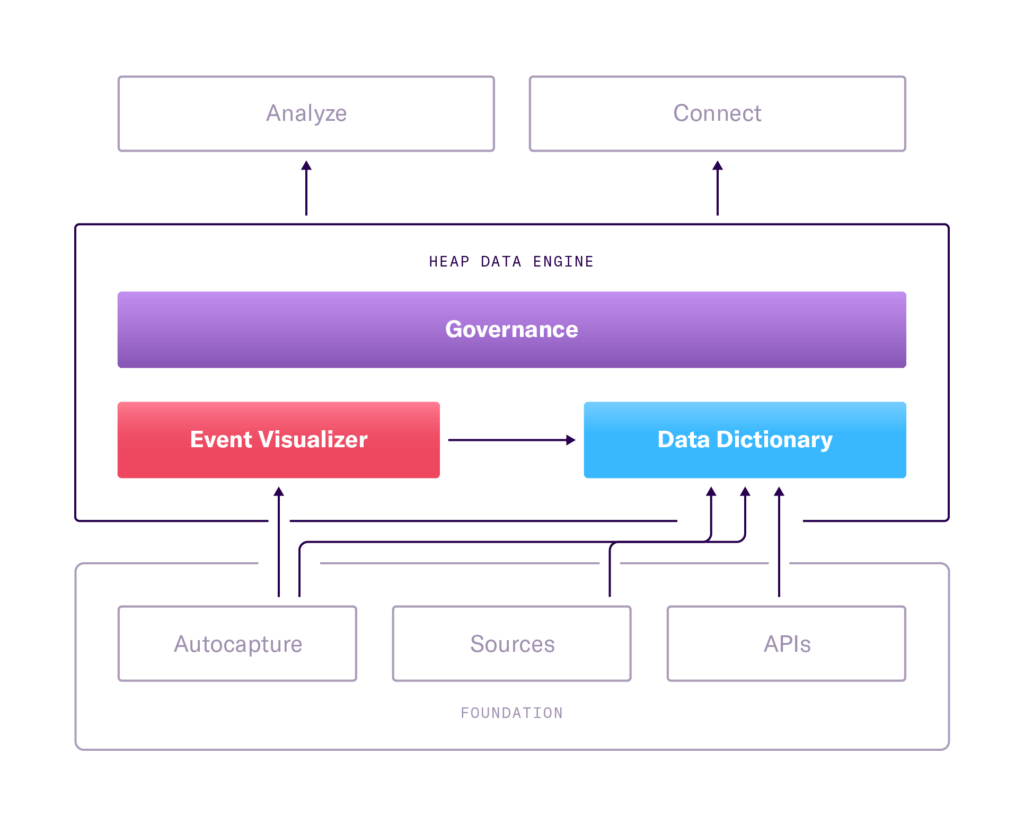Introducing the Heap Data Engine
If your team is responsible for some aspect of the digital customer experience, there’s a good chance you’re using behavioral data to inform that experience. But if you’re like most teams, you face some tricky questions.
The promise of product analytics is a complete, trustworthy dataset that everyone on the team can use to make smarter decisions. Sounds great, right? Well unfortunately, this promise has never been fully realized.
At the root of this unmet promise is a 3-way tradeoff that most teams face when setting up product analytics. It goes like this: your dataset gets to be ONLY two of the following: 1) complete, 2) trustworthy, and 3) easy to set up and maintain.
If you have Google Analytics, it’s pretty easy to get going and the data is trustworthy, but it’s far from complete. If you use an old school manually-tracked solution, you can get to a point of trustworthy, complete data, but not without gargantuan company-wide effort. If you use a basic autotrack solution, you likely end up with a dataset that is fairly complete and simple to set up, but over time, data quality erodes and trust goes out the window.
Complete. Trustworthy. Easy to set up and maintain. Choose your favorite two.
Or … get all of them. Heap's Data Engine eliminates this tradeoff, allowing teams to build a dataset that is complete, trustworthy, and easy to set up and maintain. This means anyone can access the data they want, analyze it with flexibility, and leverage it to build a powerful user experience. Finally, the promise of product analytics has been made real.
The Heap Data Engine
The Heap Data Engine offers a new approach to constructing, organizing, and scaling your company’s user data.
Built on a foundation of complete, autocaptured data, the Heap Data Engine gives teams the flexibility to organize that data and answer the questions that matter to them. With Heap, your data stays trustworthy and scalable, your team stays organized, and your product stays focused on delivering value to users.
The Heap Data Engine is built to help you do three things:
Construct your dataset with maximum agility
Organize your data
Scale access to data with collaborative workflows
Let’s explore these.
Construct your dataset with maximum agility
Heap gives you a complete set of user data and extreme agility when analyzing it.
In most other analytics tools, setting up a new event requires engineering effort, spreadsheets, meetings, and potentially months of waiting.
Heap's web and mobile Event Visualizers give everyone on your team immediate access to the data they need and endless flexibility in how they organize it. It’s simple for anyone to locate the events that matter to them, and to flexibly group and label those events to best answer their questions.
For example, if you have a question about how users are interacting with a “Share Report” feature, all you need to do is click on the relevant elements on your site/app through our Event Visualizer and apply a name to each event. In seconds, you’ll have immediate access to retroactive data going back to when you installed Heap – all without engineering effort, and without needing a crystal ball to predict your future questions.
The same principles apply to setting up segments (groups of users) and properties (contextual information about users and events). Since Heap stores all of your historical product data behind the scenes, it’s simple to use our drag-and-drop interfaces to name and organize new user segments and properties as new questions arise.
With Heap, any user can rapidly pivot from question to question, without limitation and without dependencies.
Organize your data
The cleaner the dataset, the more trustworthy and usable.
Heap’s Data Dictionary is a single surface for dataset administrators to clean, organize, and annotate your dataset. It keeps your data trustworthy, up-to-date, and consistent across the company, maximizing your team’s ability to generate insights.
Because autocapture gives you so much more data than other tools, it’s critical to keep that data clean and organized, while maintaining flexibility and agility. Data Dictionary allows admins to create and enforce naming conventions, categorize data so it can be easily discovered, and add annotations that give data consumers confidence in their analysis.
When data is transparent, up-to-date, neatly organized, and consistently named, anyone can quickly and confidently answer questions.
Finally, a data experience that sparks joy!
Scale access to data with collaborative workflows
When teams conduct analysis in silos, insights rarely turn into action. The decisions that move the needle are usually made on a team-wide level. Shouldn’t your data make it easy for your team to work together?
Heap’s Governance keeps everyone on the same page, future-proofing your dataset and democratizing access to everyone in the org.
Personal spaces give users the freedom to explore data without impacting the shared dataset. When an event or report is worth sharing, it’s easy to publish it to the shared space.
Verification workflows ensure that newly created or published definitions are clear and accurate. When someone creates a definition, it is automatically submitted for verification by data administrators. Administrators can inspect the definition and make any needed changes or annotations before verifying.
To keep everything up-to-date, smart workflows alert admins about stale and unused definitions, and guide admins to fix or archive them.
When everyone is on the same page, insights flourish.

The Heap Data Engine represents the next step in helping teams discover product insights. It’s just the first step in our goal of bringing shared insights to companies of all sizes and in all verticals.
We encourage you to explore Heap's Data Engine features, and to learn more about our approach to data and insights.
